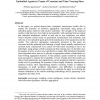482 search results - page 2 / 97 » On the Size of Reactive Plans |
ICML
1990
IEEE
13 years 8 months ago
1990
IEEE
Given an adequate simulation model of the task environment and payoff function that measures the quality of partially successful plans, competition-based heuristics such as geneti...
IVA
2010
Springer
13 years 3 months ago
2010
Springer
Abstract. Generating coordinated multimodal behavior for an embodied agent (speech, gesture, facial expression. . . ) is challenging. It requires a high degree of animation control...
ECAIW
2000
Springer
13 years 8 months ago
2000
Springer
The aim of this paper is to present a framework for developing intelligent agents that act in dynamic and unpredictable environments in a robust and efficient way. To achieve this ...
ETFA
2008
IEEE
13 years 11 months ago
2008
IEEE
While current manufacturing systems are built to avoid uncertainty, the increase of setup reconfiguration frequency and ever higher numbers of variants produced on the same syste...
AROBOTS
2004
13 years 4 months ago
2004
In this paper, we present discrete-time, nonspatial, macroscopic models able to capture the dynamics of collective aggregation experiments using groups of embodied agents endowed ...

